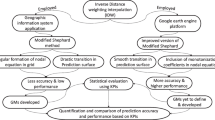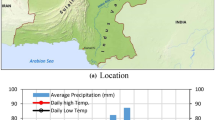Abstract
The amount of subsurface information that can be effectively collected and manipulated is abundant. The use of information and database management system can help in the problem-solving process for the engineer. In this paper, south Chennai, India has been divided into four different zones. Subsequently, four zones between the village boundaries Kandanchavadi and Padur were selected to develop geotechnical zonation maps using geographical information system (GIS). Based on sampled geotechnical data values, an estimated value is assigned to all other locations using surface creation function (topo to raster interpolation process) in GIS. The study area was contoured for SPT N values and bearing capacity (kN/m2) at 0.75, 1.5, 2.25, 3, and 3.75 m depth. Information from various interpolation techniques has been checked by cross validation, and it also based on the fact that objects that are near are more accurate than those that are far away. SPT N values and bearing capacities for various footing breadths at different depths could be computed using this GIS map with varying levels of confidence. Foundation suitability map is developed by using weighted overlay analysis. This study realizes the potential of GIS to find the solution of phenomena, that was very tedious by any other means, not only in terms of accuracy but also by the use of derived information as the input for other correlation analysis. Furthermore, the system can be used as a decision support for geotechnical engineers.





















Similar content being viewed by others
References
Anbazhagan P, Premalatha K (2004) Microzonation of liquefaction factor of safety of Chennai City. Ind Geotech Conf 1:227–230
Antoniou AA, Papadimitriou AG, Tsiambaos G (2008) A Geographical information system managing geotechnical data for Athens (Greece) and its use for automated seismic microzonation. Nat Hazards 47:369–395
David Rogers J, Luna R (2004) Impact of geographical information systems on geotechnical engineering, Proceedings of Fifth International Conference on Case studies in Geotechnical Engineering, New York, NY, April 13–17 2004, pp 1–23
Habibullah BM, Pokhrel RM, Kuwano J, Tachibana S (2012) GIS-based soil liquefaction hazard zonation due to earthquake using geotechnical data. Int J GEOMATE 2(No. 1 (Sl. No. 3)):154–160
Kunapo J, Dasari G, Phoon K, Tan T (2005) Development of a Web-GIS based geotechnical information system. J Comput Civ Eng 19(3):323–327
Mancini F, Ceppi C, Ritrovato G (2010) GIS and statistical analysis for landslide susceptibility mapping in the Daunia area, Italy. Nat Hazard Earth Syst Sci 10:1851–1864
Nayak NV (2001) Foundation design manual for practicing engineers, 4th edn. Dhanpat Rai Publication Pvt. Ltd, New Delhi
Okunade EA (2010) Design and implementation of a web-based geotechnical database management system for Nigerian soils. Mod Appl Sci 4(11):36–42
Roch Player (2000) Using GIS in preliminary geotechnical site investigations for transportation projects, Proceedings of Mid-Continent Transportation Symposium 2000, pp 174–177
Sitharaman TG, Sudarshan MS, Narashimha Raju PSR, Shamanth K, Mahesh GU (2004) “Geotechnical site characterization map in 3D for Bangalore City, Proceedings of Indian Geotechnical Conference 2004, NIT, Warangel, India, pp. 33–36
Smith SJ, Burgess MM, Chartrand J, Lawrence DE (2005) Digital borehole geotechnical database for the Mackenzie Valley/Delta Region. Geol Surv Can Open File 4924:25
Teng WC (1965) Foundation design. Prentice-Hall, New Delhi
Vahidnia MH, Alesheikh AA, Alimohammadi A, Hosseinali F (2009) Landslide hazard zonation using quantitative methods in GIS. Int J Civ Eng 7(3):176–189
Acknowledgments
The authors would like to thank Mr. I.V. Anirudhan, Director, M/s Geotechnical Solutions, Chennai - 42, India for providing the reliable geotechnical data within the study area.
Author information
Authors and Affiliations
Corresponding author
Rights and permissions
About this article
Cite this article
Stalin, V.K., Murugan, R.B.A. Geographic information system for the development of soil suitability map in south Chennai, India. Arab J Geosci 8, 1415–1437 (2015). https://doi.org/10.1007/s12517-014-1323-0
Received:
Accepted:
Published:
Issue Date:
DOI: https://doi.org/10.1007/s12517-014-1323-0




